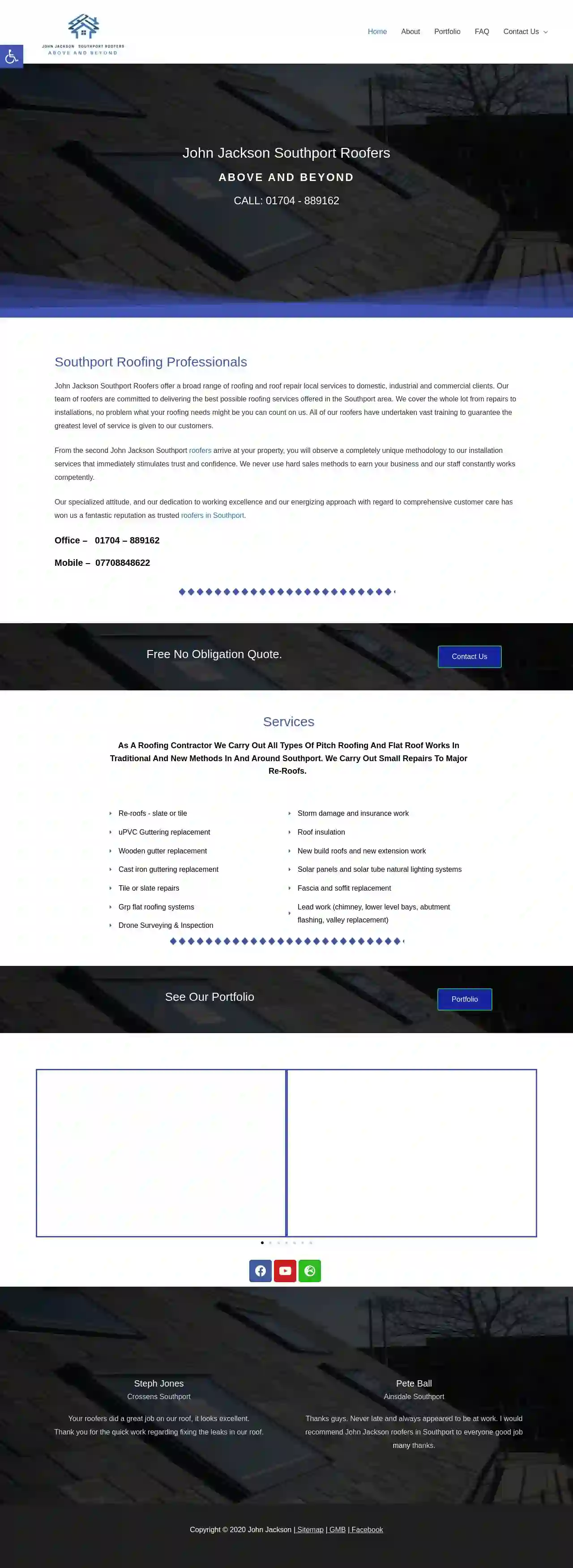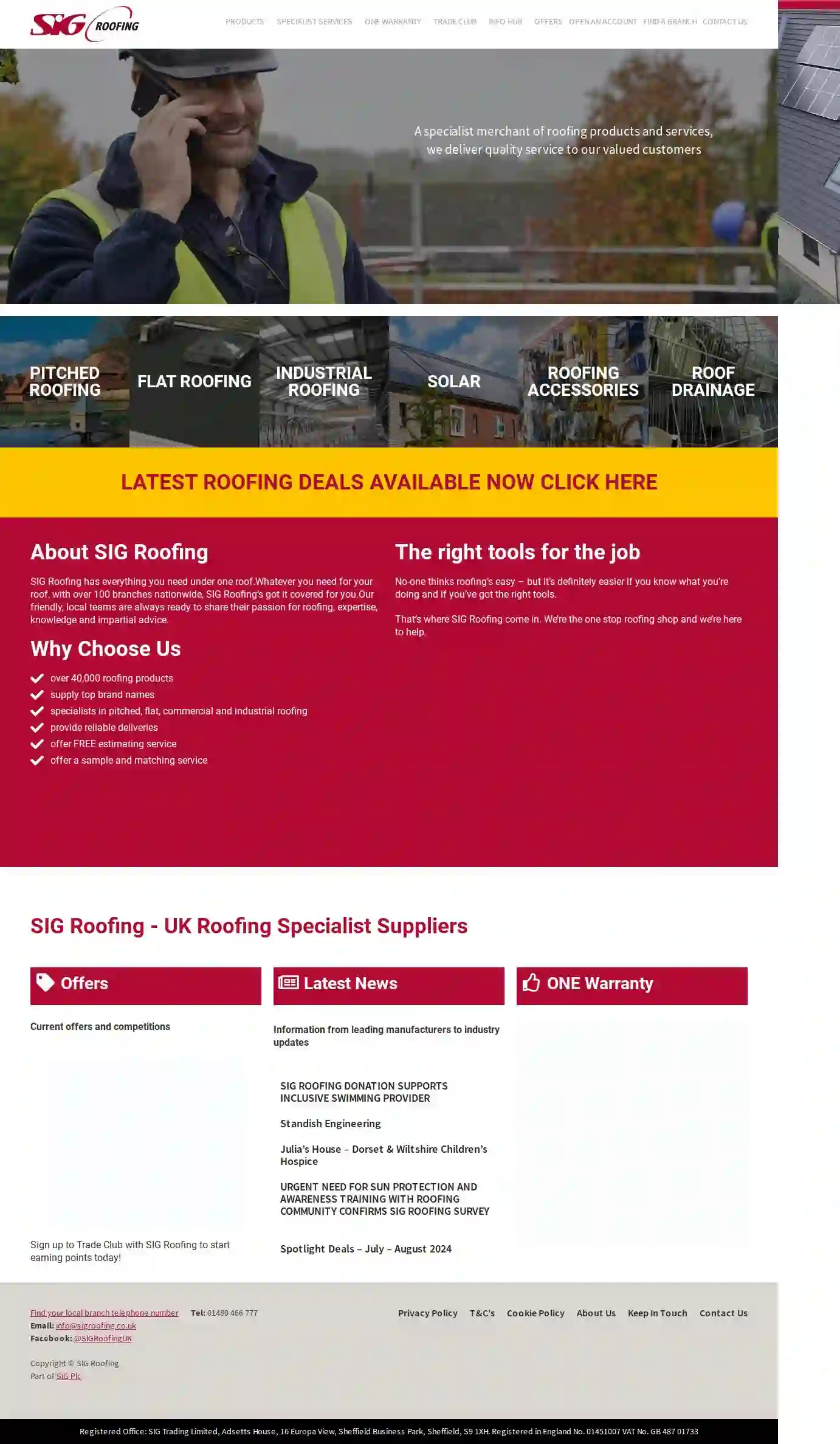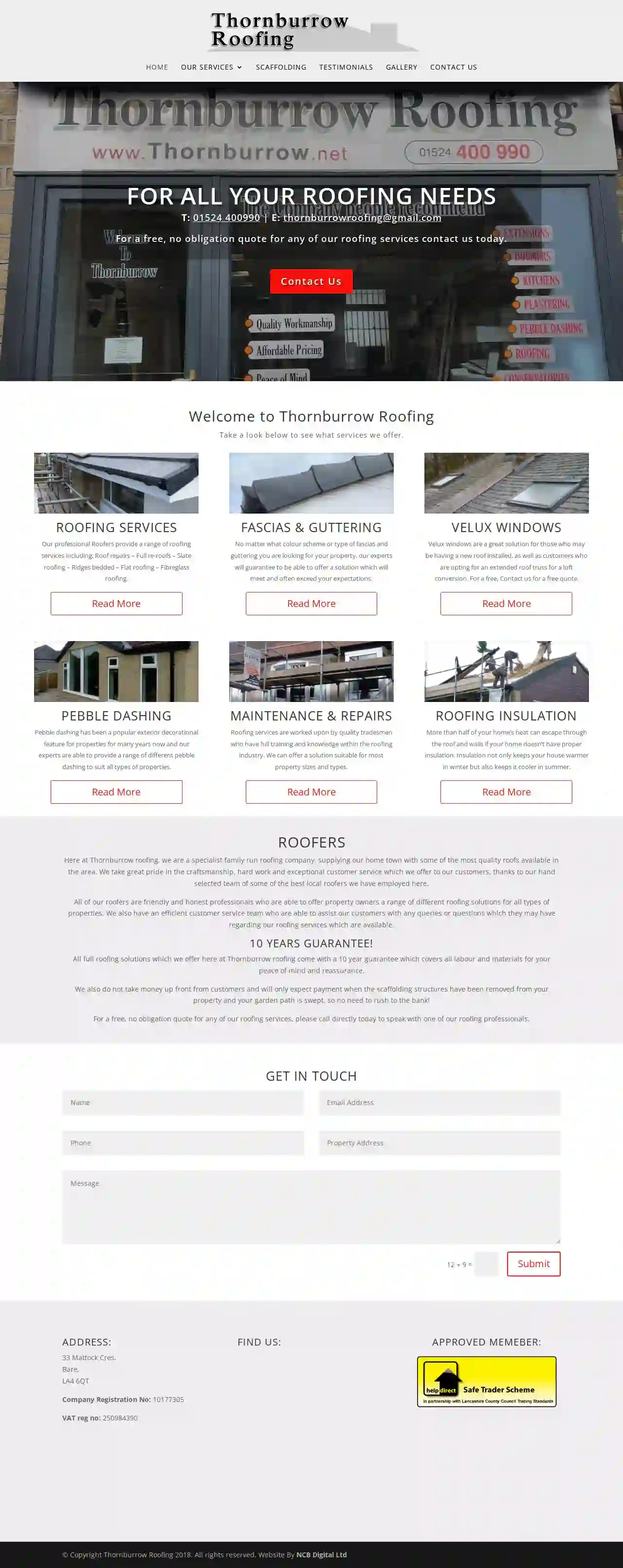Cedar Shake Roofers Blackpool
Find the best Wood Shake Roofing in Blackpool
Get up to 3 Wood Shake Roofer quotes for your project today! Compare profiles, reviews, accreditations, portfolio, etc... and choose the best deal.

Chris Moody Roofing
4.979 reviewsUnit 1 West Park View, Dudley, Cramlington, NE23 7AA, GBChris Moody Roofing and Building is a 'Checked and vetted' & 'Trading standards approved' family run business based in Wideopen, Newcastle. Trading since 2011, with over 15 years’ experience in the roofing and building trade. We specialise in all types of roofing and external building works. We pride Ourselves on our commitment to provide a Professional, Personal and Speedy service from quote to completion, whilst maintaining the highest quality of work and using top quality materials.
- Services
- Why Us?
- Accreditations
- Our Team
- Testimonials
- Gallery
Get Quote
A1 Roofing Preston
52 reviewsAshton-on-Ribble, Preston, 89c Wellington Rd, GBA1 Roofing Preston is a roofing services company based in Preston, Lancashire, UK. We offer a range of services including chimney repair, shingle roofing, asphalt roofing, and more. Our team is dedicated to providing 24-hour, seven-day-a-week roofing services to our clients in Preston and surrounding areas. We serve a diverse clientele, including consumers, firms, and enterprises, and are committed to delivering outstanding results. With our expertise and commitment to quality, you can trust A1 Roofing Preston to get the job done right.
- Services
- Why Us?
- Gallery
Get Quote
John Jackson Roof Building Construction
4.611 reviewsCemetery Road, Unit 8, George Business Park, Southport, PR8 5EG, GBJohn Jackson Southport Roofers is a family-run business with almost 15 years of experience in the roofing industry. John Jackson, the director, began his roofing career in 2001 and spent twelve years working for a local family roofing business before starting his own company in 2013. The company has built a strong reputation for providing high-quality roofing services to domestic, industrial, and commercial clients in Southport and the surrounding areas. They offer a wide range of services, including traditional slate roofing, tiling, felt roofing, lead works, chimney works, roof windows, fascia and soffit works, guttering, pointing, and many other associated building works. All work is carried out to a high standard and is guaranteed for ten years.
- Services
- Why Us?
- Accreditations
- Our Team
- Testimonials
- Gallery
Get Quote
The Tin Man | Metal Roofing Specialist
51 reviewsGBExpert Metal Sheet Roofing and Pressure Washing Services based in Lancaster, Morecambe and Surrounding Areas. The Tin Man prides itself on delivering top-quality metal sheet roofing and pressure washing solutions across Lancashire. With expertise and dedication, the Tin Man ensures your roofing needs and outdoor spaces are in safe hands. Quality Craftsmanship You Can Trust Attention to Detail in Every Project Experienced and Knowledgeable Solutions
- Services
- Why Us?
- Accreditations
- Our Team
- Testimonials
- Gallery
Get Quote
SIG Roofing Leyland
4.848 reviewsPreston, GBSIG Roofing is a specialist merchant of roofing products and services, delivering quality service to our valued customers. Established for over 40 years – with branches throughout the UK from Inverness to Plymouth. We have everything you need under one roof. Whatever you need for your roof, with over 100 branches nationwide, SIG Roofing’s got it covered for you. Our friendly, local teams are always ready to share their passion for roofing, expertise, knowledge and impartial advice.
- Services
- Why Us?
- Gallery
Get Quote
Thornburrow Roofing Ltd
3.720 reviews33 Mattock Cres, Bare, LA4 6QT, GBHere at Thornburrow roofing, we are a specialist family run roofing company, supplying our home town with some of the most quality roofs available in the area. We take great pride in the craftsmanship, hard work and exceptional customer service which we offer to our customers, thanks to our hand selected team of some of the best local roofers we have employed here. All of our roofers are friendly and honest professionals who are able to offer property owners a range of different roofing solutions for all types of properties. We also have an efficient customer service team who are able to assist our customers with any queries or questions which they may have regarding our roofing services which are available. 10 years guarantee! All full roofing solutions which we offer here at Thornburrow roofing come with a 10 year guarantee which covers all labour and materials for your peace of mind and reassurance. We also do not take money up front from customers and will only expect payment when the scaffolding structures have been removed from your property and your garden path is swept, so no need to rush to the bank! For a free, no obligation quote for any of our roofing services, please call directly today to speak with one of our roofing professionals.
- Services
- Why Us?
- Gallery
Get Quote
Dale Roofing & Building
4.312 reviews88 Kiln Ln, Eccleston, WA10 4RJ, GBYour trusted partner for top-quality roofing and building solutions. With years of experience and a team of skilled professionals, we take pride in delivering exceptional services to property owners seeking to enhance and protect their properties. From Home Extensions to Damp coursing, we offer a comprehensive range of services that cater to all your roofing and building needs.
- Services
- Why Us?
- Gallery
Get Quote
North East Industrial Roofing Ltd
54 reviewsCrosby, GBWelcome to North East Industrial Roofing LTD, your trusted partner in roofing solutions. Established a decade ago by Craig Fowler, a seasoned professional with over 15 years of experience in the industry, we stand as a beacon of reliability and excellence in the roofing business.
- Services
- Why Us?
- Our Team
- Gallery
Get Quote
Advancedcontractors ltd
Barrow-in-Furness, GBAdvanced Contractors are an experienced and trusted roofing service covering Cumbria and Lancaster. We’re a family run business based in Barrow-in-furness and cover Lancaster and Cumbria. At Advanced Contractors, we believe that a strong roof is the cornerstone of a secure and comfortable home. Serving the vibrant community of Barrow-in-Furness and its surrounding areas, we are your dedicated roofing partner, committed to delivering top-notch craftsmanship and impeccable service. With years of experience and a passion for excellence, we understand the unique demands of the Cumbria and Lancashire climate and strive to provide roofing solutions that stand the test of time. Whether you require roof repairs, a new roof, maintenance, or inspections, we have the expertise and dedication to meet your needs with precision and care.Explore our website to discover more about our services and the quality of our work. Your satisfaction and the protection of your home are our top priorities at Advanced Contractors.
- Services
- Why Us?
- Gallery
Get Quote
Longsdale Roofing
GBLongsdale Roofing offer roofing services in Bolton le Sands, Carnforth, Silverdale, Arnside, Milnthorpe, Kirkby Lonsdale, Grange over Sands, South Cumbria to include Kendal, Windermere, Ambleside and the Lake District. Longsdale Roofing install new and repair flat roofs including garage and dorma roofs. Longsdale Roofing also provide chimney repairs, repair and renew fascias and roofline and install Velux windows. Domestic and Commercial Roofing Contractors. Storm damage and insurance work welcome. No VAT From a single slate to a whole new roof', Longsdale Roofing provide it all, offering a full range of roof repairs throughout South Cumbria and the Lake District. Longsdale Roofing provide a personal and professional service and all enquiries are dealt with quickly and politely. Longsdale Roofing provide all estimates and quotes in writing and all work is carried out professionally and safely.
- Services
- Why Us?
- Gallery
Get Quote
Over 12,314+ Roofers on our platform
Our roofing experts operate in Blackpool & surrounding areas!
Roofyng.co.uk has curated and vetted the Best Roofers in and around Blackpool. Find a trustworthy contractor today.
Cedar Shake Roofing FAQs
- Renewable resource: Cedar is a renewable resource, and sustainably harvested cedar wood is readily available.
- Biodegradable: Cedar shakes are biodegradable and will decompose naturally at the end of their lifespan, unlike asphalt shingles, which contribute to landfill waste.
- Energy efficiency: Cedar wood has natural insulating properties, which can help reduce energy consumption for heating and cooling.
- Natural Beauty: Cedar shakes offer a unique, natural aesthetic that enhances curb appeal and complements various architectural styles.
- Durability: Cedar is a naturally durable wood species resistant to rot, decay, and insects.
- Weather Resistance: Cedar shakes are naturally resistant to moisture and can withstand harsh weather conditions.
- Insulating Properties: Cedar wood has good insulating properties, helping to regulate indoor temperatures and potentially reduce energy costs.
- Longevity: With proper installation and maintenance, cedar shake roofs can last for several decades.
- Cost: Cedar shake roofing is typically more expensive than asphalt shingle roofing.
- Maintenance: Cedar shake roofs require regular maintenance, such as cleaning and treatment, to maintain their appearance and extend their lifespan.
- Fire Resistance: Cedar is a combustible material, and while fire-retardant treatments are available, they may not provide the same level of fire resistance as other roofing materials.
What are the different colors available for cedar shakes?
What are the environmental considerations of cedar shake roofing?
How do I repair a damaged cedar shake?
What are the pros and cons of a cedar shake roof?
Pros of Cedar Shake Roofing:
Cons of Cedar Shake Roofing:
What are the different colors available for cedar shakes?
What are the environmental considerations of cedar shake roofing?
- Renewable resource: Cedar is a renewable resource, and sustainably harvested cedar wood is readily available.
- Biodegradable: Cedar shakes are biodegradable and will decompose naturally at the end of their lifespan, unlike asphalt shingles, which contribute to landfill waste.
- Energy efficiency: Cedar wood has natural insulating properties, which can help reduce energy consumption for heating and cooling.
How do I repair a damaged cedar shake?
What are the pros and cons of a cedar shake roof?
Pros of Cedar Shake Roofing:
- Natural Beauty: Cedar shakes offer a unique, natural aesthetic that enhances curb appeal and complements various architectural styles.
- Durability: Cedar is a naturally durable wood species resistant to rot, decay, and insects.
- Weather Resistance: Cedar shakes are naturally resistant to moisture and can withstand harsh weather conditions.
- Insulating Properties: Cedar wood has good insulating properties, helping to regulate indoor temperatures and potentially reduce energy costs.
- Longevity: With proper installation and maintenance, cedar shake roofs can last for several decades.
Cons of Cedar Shake Roofing:
- Cost: Cedar shake roofing is typically more expensive than asphalt shingle roofing.
- Maintenance: Cedar shake roofs require regular maintenance, such as cleaning and treatment, to maintain their appearance and extend their lifespan.
- Fire Resistance: Cedar is a combustible material, and while fire-retardant treatments are available, they may not provide the same level of fire resistance as other roofing materials.